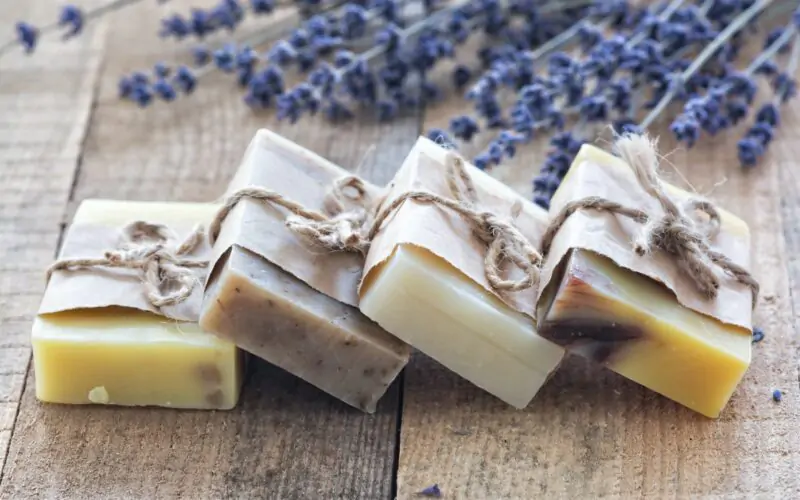Discussion on How to Make a Homemade Soap: Making homemade soap is a fun and easy craft that can be done by people of all ages. Not only is it a fun activity, but it also allows you to customize your soap with your favorite scents and colors.
In a world saturated with commercial products, there's something deeply satisfying about creating your own items, especially when it comes to something as essential as soap.
Imagine cleansing your skin with a bar that you've carefully crafted with natural ingredients and a touch of your personal creativity. This guide will take you on a journey into the art of soap making. From selecting the best ingredients to molding your unique bars, we'll cover it all.
So, roll up your sleeves, gather your supplies, and let's learn how to make a homemade soap that's not only cleansing but also a reflection of your care for yourself and the environment.
READ ALSO: How to Make a Homemade Laundry Detergent
How to Make a Homemade Soap

Gathering Your Supplies
Before we dive into the soap-making process, it's crucial to have all your supplies ready. Here's a list of what you'll need:
- Oils and Fats: Coconut oil, olive oil, shea butter, and more.
- Lye: Caustic soda used for saponification.
- Liquid: Water, herbal tea, or milk.
- Additives: Essential oils, herbs, colorants, exfoliants.
- Equipment: Stainless steel pot, thermometer, hand blender, molds.
READ ALSO: How to Start a Side Hustle with Your Hobby
Ensuring Safety First
Working with lye requires caution. Make sure to follow safety measures, such as wearing gloves and eye protection. Work in a well-ventilated area to avoid inhaling fumes.
Keep vinegar nearby to neutralize lye spills.
Calculating the Ingredients
Use an online soap calculator to determine the precise quantities of oils, lye, and liquid based on the desired properties of your soap.
READ ALSO: How to Make Cleaning Products of Your Own
Step-by-Step Soap Making Procedure
- Measuring Oils: Weigh the oils and fats in your recipe and melt them in a stainless steel pot.
- Preparing Lye Solution: Carefully mix lye into your chosen liquid. Remember, lye should always be added to liquid, not the other way around.
- Combining Lye and Oils: Once both the lye solution and oils reach a similar temperature, slowly pour the lye into the oils while stirring.
- Emulsification: Use a hand blender to mix until the mixture reaches trace—a stage where it thickens like custard.
- Adding Additives: Incorporate essential oils, herbs, colorants, or exfoliants at trace.
- Molding: Pour the soap batter into molds. Silicone molds are excellent for beginners.
- Curing: Cover the molds and let the soap cure for about 4-6 weeks. This allows excess water to evaporate, resulting in a harder, longer-lasting bar.
- Unmolding and Cutting: Once cured, gently unmold the soap and cut it into bars.
- Aging: Allow the bars to age for an additional few weeks to enhance their quality.
Crafting Soap with Care
Crafting soap goes beyond the ingredients and steps. It's about infusing care and creativity into your bars. Personalize your soap by experimenting with scents, colors, and textures.
Whether you're making a soothing lavender soap or an exfoliating citrus blend, let your imagination run wild.
READ ALSO: How to Make a Homemade Shampoo (Crafting Natural Hair Care Delight)
FAQs about Making Homemade Soap
Can I use any oil for soap making?
While many oils work, some are better suited due to their fatty acid composition. Research and experimentation will help you find the best combinations.
Why is lye essential in soap making?
Lye, when combined with oils, undergoes a chemical reaction called saponification, transforming them into soap.
Can I use fragrance oils instead of essential oils?
Yes, but natural essential oils are often preferred for their therapeutic properties.
How can I add exfoliants to my soap?
Add exfoliants like ground coffee or oatmeal at trace to retain their texture in the soap.
Is it safe to use homemade soap on sensitive skin?
Homemade soap allows you to control the ingredients, making it suitable for sensitive skin. However, always conduct a patch test.
What if my soap turns out too soft?
Soft soap might be a result of excess water or insufficient curing. Let it cure for a few more weeks to harden.
READ ALSO: How to Make a Homemade Lip Balm – (Crafting Your Perfect Lip Care Solution)
Summary
There you have it, a simple guide on how to make a Homemade Soap by yourself. Learning how to make a homemade soap is not only a delightful journey but also an opportunity to craft a meaningful product that cares for your skin and the planet.
Through this process, you'll gain an appreciation for the artistry of soap making and the joy of creating something uniquely yours. So, gather your ingredients, embrace your creativity, and embark on a soap-making adventure that's both rewarding and cleansing.
By following these simple steps, you can create your own unique homemade soap. Remember to always use caution when working with lye, and have fun experimenting with different scents and colors.
Thank you for reading our article today! Please remember to share this article on social media to help others benefit too. It also helps us improve our algorithm and relevance to the public. Thanks for Sharing!!! Follow us on Socials: Facebook - LinkedIn - Twitter
Discover more from Internet Parrot
Subscribe to get the latest posts sent to your email.









